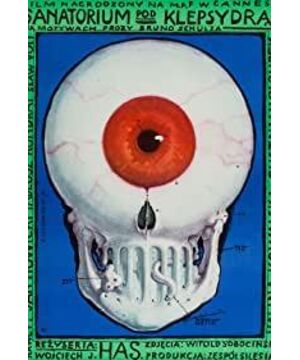"Sanatorium under the Mirror of Sand Making" can be said that visual metaphors run through the whole film, thus forming a metaphysics of visual presence, allowing the plot of the whole film to gradually unfold through visual feelings. In Plato's "cave metaphor", the process of the prisoner obsessed with the illusion of the cave fleeing to the real world is the process of obtaining the revelation of the truth by virtue of noble vision, that is, the rational eye of the mind, and it is the prisoner who gets rid of the shackles and obtains the knowledge of the true self. process. In this film, Haas sets up a man who is looking for his father, and the background of the story is set in the early days of World War II. In the process of looking for his father, this character does not follow the conventional narrative mode to complete the entire search process, but Abandoning the mode of true narrative, let the characters complete a spiritual journey.
Here it can be said that the subject of the film is no longer a centralized subject, but a centrifugal subject, a subject who cannot find an outlet in the torment of desire. Then, what is the desire that makes the character suffer? A good answer has been given in the film, which is death, and this film is a grand death-defying journey.
The story background of this film is set in the early stage of World War II, and this design gives the film a strong prophetic nature. "Sanatorium under the Mirror of Sand Making" was filmed in 1973. World War II ended in 1945. Haas was born in 1925. It can be said that Haas was a witness of World War II. The damage Poland suffered in World War II is obvious to all. After witnessing the disaster brought by the war, Haas must have indelible traces in his heart, and these traces are the various images in "Sanatorium under the Mirror of Sand Making".
The male protagonist in the film is Haas himself. Haas uses the eyes of others to complete his journey of memories. He is like a timid and curious child who accidentally enters the realm of Yuanhuang. He can only hold tightly. Pulling on the corner of fate's clothes, I move forward step by step in the colorful narrative. However, he did not walk into that beautiful garden, but saw a barren and lonely nightmarish world, the dilapidated ruins of the winter season, the dark corners, the rotten withered grass, the broken tiles and the indifferent tombstones. .....These strong gaps create a gloomy dream.
After the end of World War II, the whole of Poland was completely broken. The end of the war originally brought the joy of new life, just like the bird of paradise in the movie. However, the ideology after the war has gradually become desolate. Most of the people who have experienced the war survived, but in the end, they are still dying, irresistible and powerless to reverse. The entire film describes a war, and Haas uses his own way to complete the narrative of the war.
When the image culture of film, TV, and commercial advertisements is fully permeated in life, visual centralism has become an established and nightmare-like existence. In "Sanatorium under the Mirror of Sand Making", between what the audience sees and what is seen on the screen, the invisible subject becomes an alien puppet under visibility. What he is looking for is not his father, but the reflection of the light before his death. , his dream is the experience of his existence, those fragmented pictures are the whole of his life, when he shows it all, his life has lost all meaning, when he struggles before the grave, That is the feeling of powerlessness like a gossamer.
Haas creates a closed world for the audience, ignoring the presence of the audience, allowing the nightmare to magically unfold, thereby creating a sense of isolation between life and death, thereby making the imagery more full and convincing. In this film, images constitute the matrix of imagination, and at this moment, the charm of the film itself is enough to cause temporary loss of self, thereby visually strengthening the self, this "self" is only for the film in terms of roles. The beauty of the movie does not run through the beginning and end of the movie. On the contrary, the bizarre world is closely related to the celebration before the arrival of the god of death. The whole movie describes the war, expounds Haas's unique view of life and death, and expresses a A grand death-defying journey.
View more about The Hourglass Sanatorium reviews







